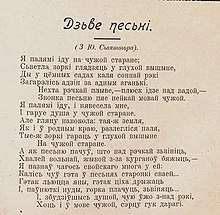Maksim Bahdanovič
Maksim Adamavič Bahdanovič (Belarusian language: Максім Адамавіч Багдановіч, [makˈsʲɪm əˈdamɐvit͡ɕ bəɣdɐnˈovit͡ɕ], Russian: Максим Адамович Богданович, romanized: Maksim Adamovich Bogdanovich, 9 December 1891 – 25 May 1917) was a Belarusian poet, journalist, translator, literary critic and historian of literature. He is considered as one of the founders of the modern Belarusian literature.[1]
Maksim Bahdanovich | |
|---|---|
 | |
| Native name | Максім Багдановіч |
| Born | 9 December 1891 Minsk, Minsk Governorate, Russian Empire (now Belarus) |
| Died | 25 May 1917 (aged 25) Yalta, Taurida Governorate, Russian Empire (now Ukraine) |
| Pen name | «Максім Кніжнік», «Maksim Knizhnik» |
| Occupation | poet, publicist, translator, literary critic |
| Period | 1907-1917 |
| Genre | verse, poem |
| Literary movement | Impressionism, symbolism |

Life
Bahdanovič was born in Minsk in the family of Adam Bahdanovič, an important Belarusian ethnographer who through most of his career worked as a bank clerk.[1] Maksim was born in a family apartment at Karakazov House located at Trinity Hill where beside the Bahdanovich's apartment was located the First Parish School. His father was of unlanded peasantry family, while his mother (née Myakota) was of old Belarusian noble family of Kurcz coat of arms that was not adopted in the Russian Empire.[1] Grandfather on his mother side, Apanas Janovich Myakota, was a Russian veteran of the Crimean War who for his military service received a lifelong nobility.[1] Both of Maksim parents graduated pedagogical schools.[1] Later father of Maksim, Adam, was involved with members of the revolutionary anti-tsarist Narodnaya Volya organization.[1]
In 1892 the family moved to Hrodna where Maksim's father received a job at local bank. Soon after the move the future poet's mother, Maria, died of tuberculosis in 1896.
In 1896 Adam Bahdanovič moved with his children to Nizhny Novgorod, Russia. At that time Maksim wrote his first poems in the Belarusian language. In 1902 Bahdanovič attended a gymnasium. During the Revolution of 1905 he was an active participant of the strikes organised by his commilitodes.
In 1907 Nasha Niva came out with Bahdanovič's first published work — the novel Muzyka.
In June 1908 the poet's family moved to Yaroslavl'. After finishing school in 1911 Bahdanovič went to Belarus to meet important figures of the Belarusian Renaissance: Vaclau Lastouski, Ivan Luckievich and Anton Luckievich. In the same year he began studying of law at a Yaroslavl' lyceum. During his studies Bahdanovič worked at a newspaper, wrote numerous works of literature and was actively published in both Belarus and Russia.
In the beginning of 1914 his only book of poems, Vianok (A Wreath), was published in Vilna (today Vilnius).
In the summer of 1916, after absolvation of the lyceum, Maksim Bahdanovič moved to Minsk and worked there at the local guberniya administration.
In February 1917 Bahdanovič went to Crimea to be treated for tuberculosis. The treatment was unsuccessful, and that year he died in Yalta.
The poet's papers were kept at his father's house, but the collection was heavily damaged during the Russian Civil War in 1918.
His standing in Belarusian literature
In 1991–1995 a full collection of Bahdanovich's poetry was published in Belarus.
Nowadays there are museums of the poet open in Minsk (Maksim Bahdanovič Literary Museum), Hrodna and Yaroslavl'. Several streets in major cities of Belarus and Russia are named after him.
The operas Zorka Venera (by Jury Siemianiaka and Ales' Bachyla), and Maksim (by Ihar Palivoda).
Bahdanovich created many examples of social, artistic and philosophical lyrics. He was the first poet to introduce several new lyrical forms to Belarusian literature.
Maksim Bahdanovich was a translator of Paul Verlaine, Heinrich Heine, Alexander Pushkin, Ovid, Horace and other poets into Belarusian and of Janka Kupala, Taras Shevchenko, Ivan Franko into Russian.
References
- Maksim Bahdanovich: life and works (Максім Багдановіч: асоба і творчасць). Archives of Belarus.
External links
| Wikimedia Commons has media related to Maksim Bahdanovich. |